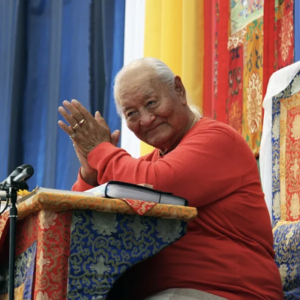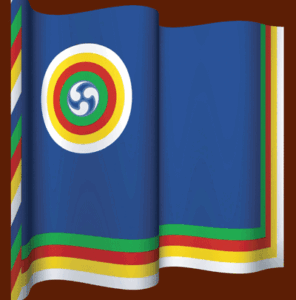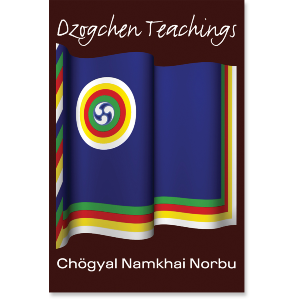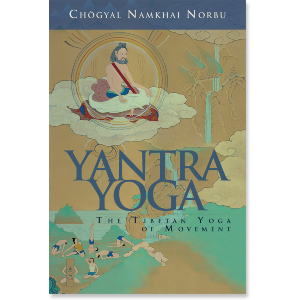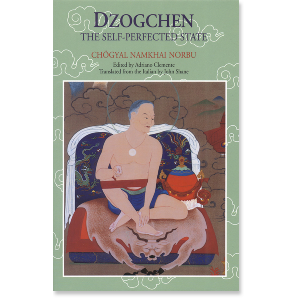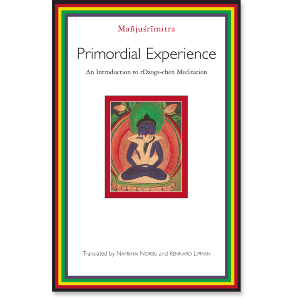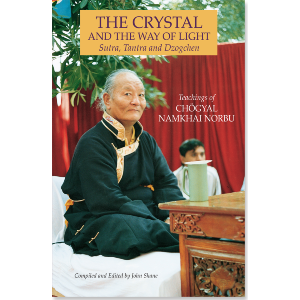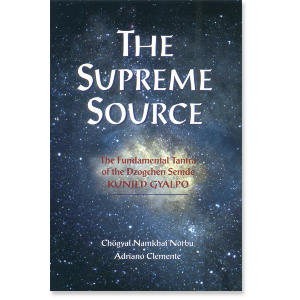Vajra
The symbol of Tantra is the vajra, which has five points at both ends and a sphere in the middle. That sphere, or thigle, represents our potentiality, which means that our real condition is beyond limitations and any kind of division into this aspect or that. At the relative level there are manifestations of all kinds of aspects, and the two main aspects are impure and pure vision, which we normally call samsara and nirvana. In the Sutra teachings they are referred to as relative and absolute truth respectively, while in Tantra impure vision corresponds to the five aggregates, and pure vision to the five Sambhogakaya Buddhas. In the symbol of the vajra, both these aspects are linked to the central sphere, which reminds us that in a real sense both of them are our own nature, our own energy. Energy is part of our real nature.
Transformation
Based on this recognition of energy as being part of our own nature, the Tantric teachings work with the path of transformation. When we speak of transformation it means that we understand the true value of things. At the level of samsara or impure vision we have the five emotions, but in Tantra we understand that their inherent nature is energy. That energy is our real nature. Only the ways that energy manifests are different. That which manifests as the five passions when we have impure vision, manifests as the five wisdoms in pure vision. In the central sphere or thigle of the vajra both of its seemingly opposite ends join, showing that pure and impure vision, afflictions and wisdoms, are both aspects of our own energy. At the level of the thigle there is no difference between the two manifestations. That is the knowledge of Tantric teachings.
Continuation
Why is this level of teaching and practice called Tantra? The real meaning of Tantra is “continuation,” or “continuity,” something continuing without interruption, which is considered our real nature. But what is it that continues? And how? We can discover this by observing ourselves. For example, if we observe ourselves we know that we have thoughts. If we observe attentively where the thought is, where it arises from and where it disappears to, we can search for a long time but we won’t find anything concrete.
What we find in the end is always emptiness because that is the basis of our condition. When we try to find our thoughts, we find this base from where thoughts proceed. Even if we find the base, that doesn’t mean that our thoughts disappear forever. After a few seconds we have another thought. We can observe it again but we won’t find anything. We can do this research for many days, but we will find only emptiness. At the same time, we also have countless thoughts which are continually arising. This continuation of thought is also part of our condition, and in this way we can find that our condition is the alternation of thoughts and emptiness. Emptiness is the base, and thoughts are its manifestation.
This manifestation occurs because there is a continuation of energy. Since this is so, how can we remain in our real nature? If we think a little of how thoughts arise, sometimes it seems that there is a connection between one thought and the next, but in the real sense they are not connected, there is always an empty space between two thoughts. If we are doing practice like Shine—the meditation practice used to develop a calm state—sometimes we can discover that this empty space is experienced for a longer duration, and we can stay for some seconds in it without any thought arising in the mind. We have a longer experience of emptiness, and then we notice that a thought arises again.
Without practice, just observing the ordinary way we habitually think, it is sometimes not so easy to discover this empty space; but in the real sense thoughts and empty space are always alternating continuously whether we are aware of this or not. That continuity is our real nature, and that is what is meant by Tantra. Tantra means our real condition. When you say the word Tantra or speak about it you already have recognition of your own energy.
The commitment of Tantra, particularly of the Higher Tantra, is to train ourselves to remain in pure vision. If you transform into a deity, whether it be peaceful, wrathful or joyful—depending on your root emotion—transforming your impure vision in this way into pure vision, you are applying that method. When you use this method according to the Tantric point of view, you are always working with pure vision.
If, for example, you are working with your anger, and in order to transform that passion, you visualize yourself as a wrathful manifestation, when you make that transformation, you are in pure vision and are no longer bound up in impure vision. When you are angry with someone in the ordinary dualistic state of mind, you are caught up in thinking that that person is very bad and that you don’t like him or her; you are angry and charged and develop that emotion. This is impure vision.
The anger that you feel is your own energy, so it is not necessary that you stop it. You can transform your feeling so that instead of being angry with someone you transform this anger into a wrathful manifestation. You don’t manifest as a wrathful form to fight with that person. You are simply no longer caught up in that impure vision. You are in pure vision, so that even if you were to continue for hours and hours in your feeling of anger you would have no problems. This is an example of how to use your pure vision. Training in pure vision is the samaya or commitment of the Tantric teachings.
That is good also for Dzogchen practitioners. For example, if you see your Vajra brothers and sisters as enlightened beings, as if they were your teacher, you will never have problems with them. On the other hand, if you always think that it’s him or her that is creating difficulties, you will always have problems. Thus it is very useful to train a little in pure vision according to the Tantric system. This is why we also need this knowledge and understanding.
Of course the methods of the various levels of the path are different. In Tantra we use transformation methods, whereas in Dzogchen the method used is that of self-liberation. If you understand how Tantric methods work, when you learn the method of self-liberation as it is practiced in Dzogchen, you can better understand what the difference is between them.
